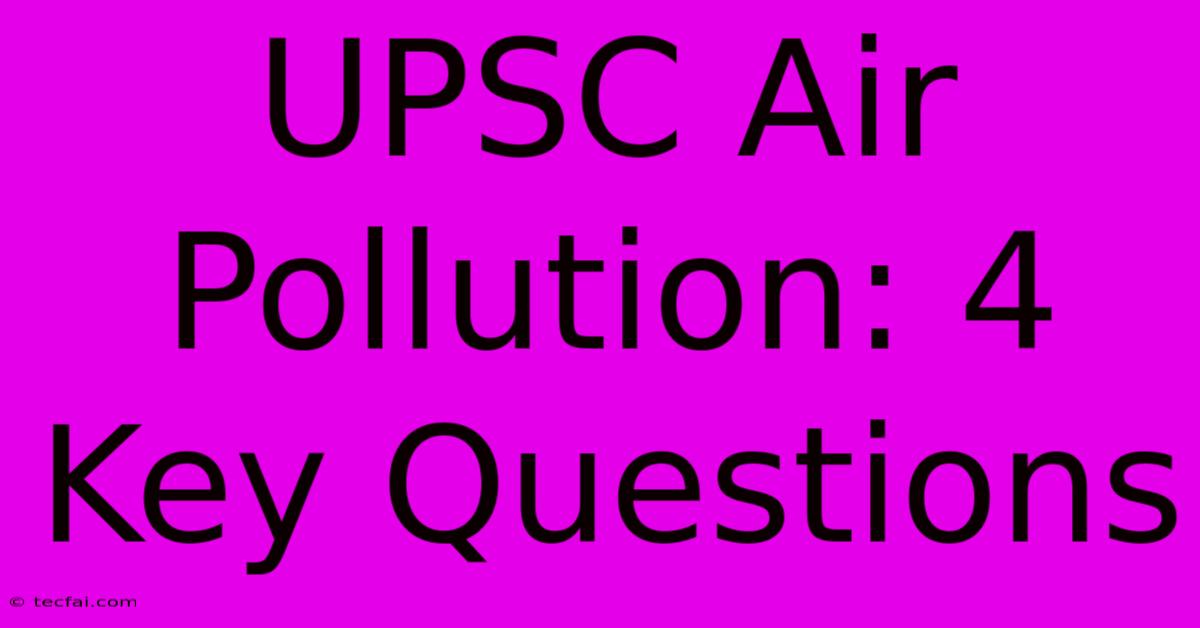UPSC Air Pollution: 4 Key Questions

Discover more detailed and exciting information on our website. Click the link below to start your adventure: Visit Best Website tecfai.com. Don't miss out!
Table of Contents
UPSC Air Pollution: 4 Key Questions
Air pollution has emerged as a critical concern in India, significantly impacting public health and the environment. The UPSC (Union Public Service Commission) exam frequently tests candidates' understanding of this complex issue. This article addresses four key questions surrounding air pollution in India, providing insights relevant to UPSC aspirants.
1. What are the Major Sources of Air Pollution in India?
India faces a multifaceted air pollution challenge stemming from diverse sources. Understanding these sources is crucial for effective policymaking and mitigation strategies.
Identifying the Culprits:
-
Vehicular Emissions: A significant contributor, particularly in urban areas. The growing number of vehicles, coupled with a reliance on older, less efficient models, leads to substantial particulate matter (PM2.5 and PM10) and gaseous pollutants like nitrogen oxides (NOx) and carbon monoxide (CO). The lack of robust public transport further exacerbates this issue.
-
Industrial Emissions: Industries, especially those in the thermal power, cement, and steel sectors, release large quantities of pollutants into the atmosphere. These emissions often include sulfur dioxide (SO2), NOx, and particulate matter, contributing significantly to regional air pollution levels. Enforcement of emission standards and industrial regulations remains a challenge.
-
Construction Activities: Rapid urbanization and infrastructure development contribute significantly to dust pollution. Construction sites often lack proper dust mitigation measures, resulting in the release of substantial amounts of particulate matter into the surrounding environment.
-
Agricultural Practices: Burning of crop residue, especially during harvest season, is a major source of air pollution, particularly in the northern plains of India. This practice releases large amounts of PM2.5 and other harmful pollutants. Promoting alternative agricultural practices is essential to address this.
-
Domestic Fuel Combustion: The use of biomass fuels (wood, dung) for cooking and heating in many households, particularly in rural areas, contributes to indoor and outdoor air pollution. This results in exposure to harmful pollutants like PM2.5 and carbon monoxide, impacting respiratory health.
2. What are the Health Impacts of Air Pollution in India?
The health consequences of India's air pollution problem are severe and far-reaching, placing a considerable burden on the healthcare system.
A Heavy Toll on Public Health:
-
Respiratory Illnesses: Air pollution is a major risk factor for respiratory diseases such as asthma, bronchitis, and pneumonia. Exposure to particulate matter can lead to reduced lung function and increased susceptibility to respiratory infections.
-
Cardiovascular Diseases: Studies have linked air pollution to an increased risk of heart attacks, strokes, and other cardiovascular diseases. Fine particulate matter can enter the bloodstream, causing inflammation and damaging blood vessels.
-
Cancer: Exposure to certain air pollutants, such as benzene and particulate matter, is associated with an increased risk of various types of cancer, including lung cancer.
-
Other Health Effects: Air pollution can also impact other aspects of health, including eye irritation, neurological problems, and impaired cognitive function, particularly in children.
3. What Government Policies and Initiatives are in Place to Combat Air Pollution?
The Indian government has implemented various policies and initiatives to tackle air pollution. While progress has been made, significant challenges remain.
Policy Landscape and Challenges:
-
National Clean Air Programme (NCAP): Aimed at reducing PM2.5 and PM10 concentrations by 2024. The NCAP sets targets for different cities and regions, promoting a collaborative approach to pollution control.
-
Vehicle Emission Standards: India has implemented Bharat Stage (BS) emission norms, gradually tightening standards to align with international best practices. The transition to BS-VI norms was a significant step in reducing vehicular emissions.
-
Industrial Emission Regulations: Regulations exist to control industrial emissions, but enforcement remains a key challenge. Stricter monitoring and penalties are needed to ensure compliance.
-
Promotion of Renewable Energy: Shifting towards renewable energy sources like solar and wind power is crucial to reduce emissions from the thermal power sector.
4. What are the Future Challenges and Potential Solutions for Air Pollution Management in India?
Addressing air pollution requires a long-term strategy focusing on multiple interventions and collaborations.
Looking Ahead:
-
Technological Advancements: Investing in and adopting advanced technologies for air pollution monitoring, control, and mitigation is critical. This includes deploying cleaner technologies in industries and promoting electric vehicles.
-
Strengthening Institutional Capacity: Enhanced monitoring, enforcement, and research capabilities are needed to effectively implement policies and evaluate their impact.
-
Public Awareness and Participation: Raising public awareness about the health risks of air pollution and encouraging active participation in mitigation efforts is essential.
-
International Collaboration: Collaboration with other countries and international organizations can facilitate knowledge sharing, technology transfer, and access to funding.
In conclusion, air pollution remains a significant challenge for India. A multi-pronged approach involving technological advancements, robust policies, public participation, and international collaboration is crucial to mitigating its impact and safeguarding public health and the environment. Understanding these complexities is vital for UPSC aspirants.

Thank you for visiting our website wich cover about UPSC Air Pollution: 4 Key Questions. We hope the information provided has been useful to you. Feel free to contact us if you have any questions or need further assistance. See you next time and dont miss to bookmark.
Featured Posts
-
Pennsylvania Senate Recount Halted
Nov 23, 2024
-
Future Of Potato Protein Market
Nov 23, 2024
-
Air Pollution Upsc Prelims And Mains
Nov 23, 2024
-
Coldplay Hull Tickets My Experience
Nov 23, 2024
-
Cole Recalls Hearing Drake First
Nov 23, 2024
